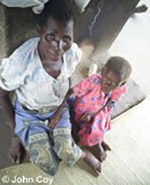Resource 1: HIV and AIDS in Africa
![]() Background information / subject knowledge for teacher
Background information / subject knowledge for teacher
http://www.avert.org/ [Tip: hold Ctrl and click a link to open it in a new tab. (Hide tip)] (Accessed 2008)
This is the web homepage of an organisation called AVERT, an international HIV and AIDS charity based in the UK, with the aim of AVERTing (preventing) HIV and AIDS worldwide.
You will find a good deal of useful information for teachers on this site.
HIV and AIDS useful facts and statistics for Sub-Saharan Africa
The AVERT site gives figures which your pupils may ask about. It also has a very useful guide to understanding the statistics.
Here is the summary of statistics for Africa. You will find more details for your own country on the website.
Sub-Saharan Africa is more heavily affected by HIV and AIDS than any other region of the world. An estimated 24.5 million people were living with HIV at the end of 2005 and approximately 2.7 million new infections occurred during that year. In just the past year the epidemic has claimed the lives of an estimated 2 million people in this region. More than 12 million children have been orphaned by AIDS.

Mother and child at Nsanje district hospital in Malawi, both HIV+
The extent of the epidemic is only now becoming clear in many African countries, as increasing numbers of people with HIV are becoming ill. In the absence of massively expanded prevention, treatment and care efforts, it is expected that the AIDS death toll on the continent will continue to rise. This means that the epidemic's impact on these societies will be felt most strongly in the course of the next ten years and beyond. Its social and economic consequences are already widely felt, not only in the health sector but also in education, industry, agriculture, transport, human resources and the economy in general.
How are different countries in Africa affected?
HIV prevalence rates vary greatly between African countries. In Somalia and Senegal the prevalence is under 1% of the adult population, whereas in South Africa and Zambia around 15–20% of adults are infected.
In four southern African countries, the national adult HIV prevalence rate has risen higher than was thought possible and now exceeds 20%. These countries are Botswana (24.1%), Lesotho (23.2%), Swaziland (33.4%) and Zimbabwe (20.1%).
West Africa has been less affected by HIV, but the prevalence rates in some countries are creeping up. Prevalence is estimated to exceed 5% in Cameroon (5.4%), Côte d'Ivoire (7.1%) and Gabon (7.9%).
Adapted from: http://www.avert.org/ subaadults.htm (Accessed 2008)
3. Using role play and scenarios



